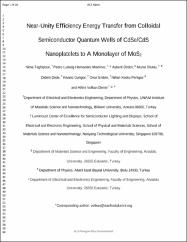Near-Unity Efficiency Energy Transfer from Colloidal Semiconductor Quantum Wells of CdSe/CdS Nanoplatelets to a Monolayer of MoS2

View/
Access
info:eu-repo/semantics/openAccessDate
2018Author
Taghipour, NimaMartinez, Pedro Ludwig Hernandez
Özden, Ayberk
Olutas, Murat
Dede, Didem
Güngör, Kıvanç
Demir, Hilmi Volkan
Metadata
Show full item recordAbstract
A hybrid structure of the quasi-2D colloidal semiconductor quantum wells assembled with a single layer of 2D transition metal dichalcogenides offers the possibility of highly strong dipole-to-dipole coupling, which may enable extraordinary levels of efficiency in Forster resonance energy transfer (FRET). Here, we show ultra-high-efficiency FRET from the ensemble thin films of CdSe/CdS nanoplatelets (NPLs) to a MoS2 monolayer. From time-resolved fluorescence spectroscopy, we observed the suppression of the photoluminescence of the NPLs corresponding to the total rate of energy transfer from similar to 0.4 to 268 ns(-1). Using an Al2O3 separating layer between CdSe/CdS and MoS2 with thickness tuned from 5 to 1 nm, we found that FRET takes place 7- to 88-fold faster than the Auger recombination in CdSe-based NPLs. Our measurements reveal that the FRET rate scales down with d(-2) for the donor of CdSe/CdS NPLs and the acceptor of the MoS2 monolayer, d being the center-to-center distance between this FRET pair. A full electromagnetic model explains the behavior of this d(-2) system. This scaling arises from the delocalization of the dipole fields in the ensemble thin film of the NPLs and full distribution of the electric field across the layer of MoS2. This d(-2) dependency results in an extraordinarily long Forster radius of similar to 33 nm.

















